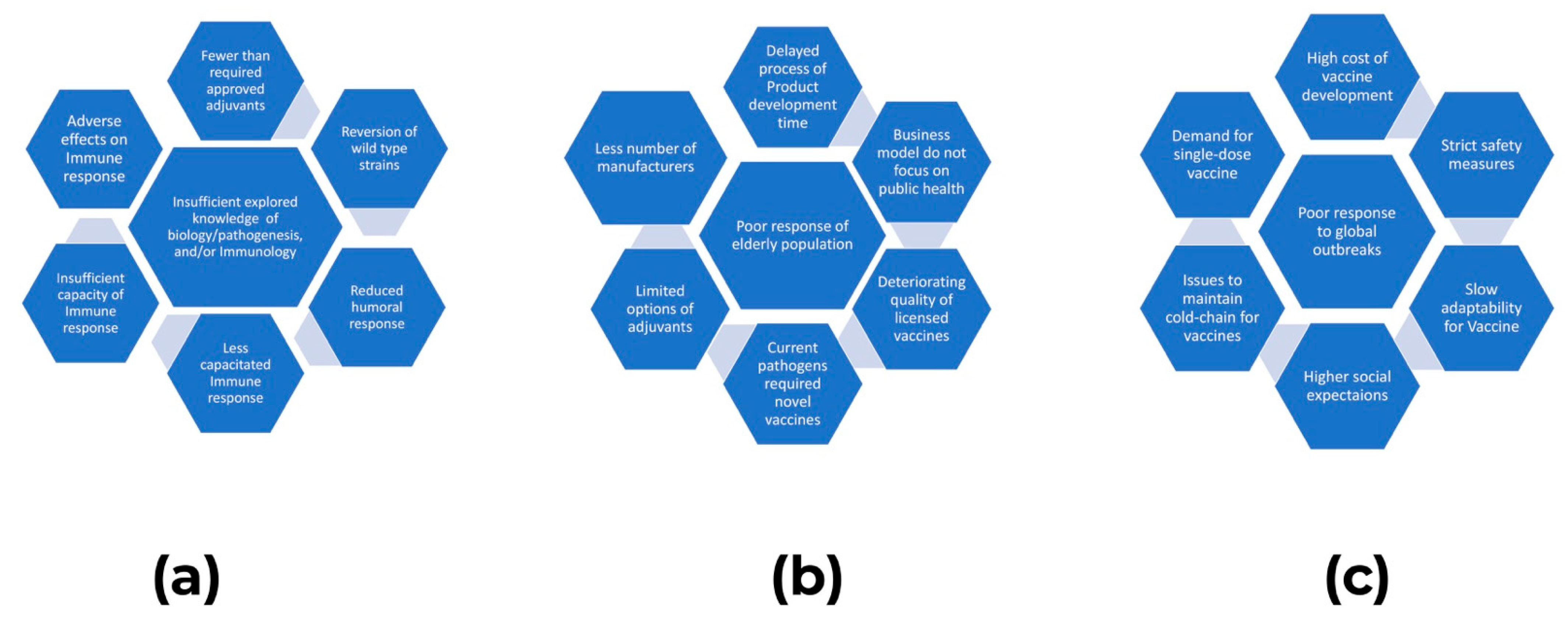Recent Global Trends in Vaccinology, Advances and Challenges
1. Background
2. Challenges
- Poor health services in third world countries make it inaccessible for individuals to not only be immunized with new vaccines, but also to the basic, existing vaccines;
- Safety is a major concern for some individuals that hinder them from getting vaccinated;
- The process of developing a vaccine to launching it in the market takes years, and until that time, a particular disease may have already infected the majority of the population;
- Genetic variability, especially in the RNA viruses, makes it challenging to make develop a vaccine against these pathogens;
- Immunosenescence in elderly people hampers the effectiveness of vaccines, and elderly experience high morbidity and mortality from infections;
- Some important pathogens, such as HIV, Malaria, and TB, evade and manipulate the host’s immune response, which makes it very difficult to develop a vaccine against these pathogens.
3. Approaches to Tackle Challenges (Adapted from [5,6])
- Studies on systems biology are required;
- Non-humoral correlates of protection are required to be identified;
- Effector functions that are related to quick recovery from infection should be identified and explored;
- Vaccines should have the ability to elicit a significant cellular response in addition to a humoral response, and vice versa;
- Population dynamics should be considered when producing and/or implementing vaccines;
- Vaccine response should be accurately measured from time to time, and for that, effective diagnostic tests should be used;
- Vaccines should produce a broad spectrum of neutralizing efficacies of antibodies;
- Multivalent vaccines should preferably be launched;
- Novel approaches to vaccine production, such as subunit vaccines, protein-based vaccines, and peptide-based vaccines with novel adjuvants, should be produced for durable and target-specific protection where applicable;
- Vaccines should employ dose-sparing approaches;
- Herd immunity, in the case of pandemics, is an effective solution;
- Impacts of aging on vaccines should be considered during their production;
- Safety should be a top priority;
- Business models should focus on public health at a priority;
- Access to the vaccines should be quick and unanimous for the public;
- Vaccine awareness should be equally prioritized with the same spirit by which the vaccine was produced, because anti-vaccine movements undo significant progress quickly;
- Genetic variabilities should be baseline for vaccine production;
- Novel approaches need to be explored to speed up the process of vaccine development. An example for this is COVID-19 vaccines, as with routine vaccine development, it takes 10 years for the vaccine to reach the public.
4. Advances in Vaccines
5. Recommendations
Author Contributions
Funding
Conflicts of Interest
References
- World Health Organization. Quantitative Risk Assessment of the Effects of Climate Change on Selected Causes of Death, 2030s and 2050s; World Health Organization: Geneva, Switzerland, 2014; ISBN 9789241507691. [Google Scholar]
- Chang, A.Y.; Riumallo-Herl, C.; Perales, N.A.; Clark, S.; Clark, A.; Constenla, D.; Garske, T.; Jackson, M.L.; Jean, K.; Jit, M.; et al. The Equity Impact Vaccines May Have On Averting Deaths And Medical Impoverishment In Developing Countries. Health Aff. 2018, 37, 316–324. [Google Scholar] [CrossRef] [PubMed]
- Aziz, M.H.; Shabbir, M.Z.; Ali, M.M.; Asif, Z.; Ijaz, M.U. Immunoinformatics Approach for Epitope Mapping of Immunogenic Regions (N, F and H Gene) of Small Ruminant Morbillivirus and Its Comparative Analysis with Standard Vaccinal Strains for Effective Vaccine Development. Vaccines 2022, 10, 2179. [Google Scholar] [CrossRef] [PubMed]
- Ahmad, W.; Shabbir, M.A.; Ahmad, M.; Omer, M.O.; Mushtaq, R.M.; Aroosa, S.; Iqbal, A.; Majeed, A. Insights into the Prognostic Role of Serum Interleukin-6 and Hematobiochemical Alterations in Cattle during Recent Outbreaks of Lumpy Skin Disease in Lodhran District, Pakistan. Vaccines 2023, 11, 113. [Google Scholar] [CrossRef] [PubMed]
- Kennedy, R.B.; Ovsyannikova, I.G.; Palese, P.; Poland, G.A. Current Challenges in Vaccinology. Front. Immunol. 2020, 11, 1181. [Google Scholar] [CrossRef] [PubMed]
- Pollard, A.J.; Bijker, E.M. A guide to vaccinology: From basic principles to new developments. Nat. Rev. Immunol. 2021, 21, 83–100. [Google Scholar] [CrossRef] [PubMed]
- Gebre, M.S.; Brito, L.A.; Tostanoski, L.H.; Edwards, D.K.; Carfi, A.; Barouch, D.H. Novel approaches for vaccine development. Cell 2021, 184, 1589–1603. [Google Scholar] [CrossRef] [PubMed]
- Wimmers, F.; Pulendran, B. Emerging technologies for systems vaccinology—multi-omics integration and single-cell (epi)genomic profiling. Curr. Opin. Immunol. 2020, 65, 57–64. [Google Scholar] [CrossRef] [PubMed]
- Rappuoli, R. Reverse vaccinology. Curr. Opin. Microbiol. 2000, 3, 445–450. [Google Scholar] [CrossRef] [PubMed]

Disclaimer/Publisher’s Note: The statements, opinions and data contained in all publications are solely those of the individual author(s) and contributor(s) and not of MDPI and/or the editor(s). MDPI and/or the editor(s) disclaim responsibility for any injury to people or property resulting from any ideas, methods, instructions or products referred to in the content. |
© 2023 by the authors. Licensee MDPI, Basel, Switzerland. This article is an open access article distributed under the terms and conditions of the Creative Commons Attribution (CC BY) license (https://creativecommons.org/licenses/by/4.0/).
Share and Cite
Aqib, A.I.; Anjum, A.A.; Islam, M.A.; Murtaza, A.; Rehman, A.u. Recent Global Trends in Vaccinology, Advances and Challenges. Vaccines 2023, 11, 520. https://doi.org/10.3390/vaccines11030520
Aqib AI, Anjum AA, Islam MA, Murtaza A, Rehman Au. Recent Global Trends in Vaccinology, Advances and Challenges. Vaccines. 2023; 11(3):520. https://doi.org/10.3390/vaccines11030520
Chicago/Turabian StyleAqib, Amjad Islam, Aftab Ahmad Anjum, Md Atiqul Islam, Asad Murtaza, and Aziz ur Rehman. 2023. "Recent Global Trends in Vaccinology, Advances and Challenges" Vaccines 11, no. 3: 520. https://doi.org/10.3390/vaccines11030520
APA StyleAqib, A. I., Anjum, A. A., Islam, M. A., Murtaza, A., & Rehman, A. u. (2023). Recent Global Trends in Vaccinology, Advances and Challenges. Vaccines, 11(3), 520. https://doi.org/10.3390/vaccines11030520





